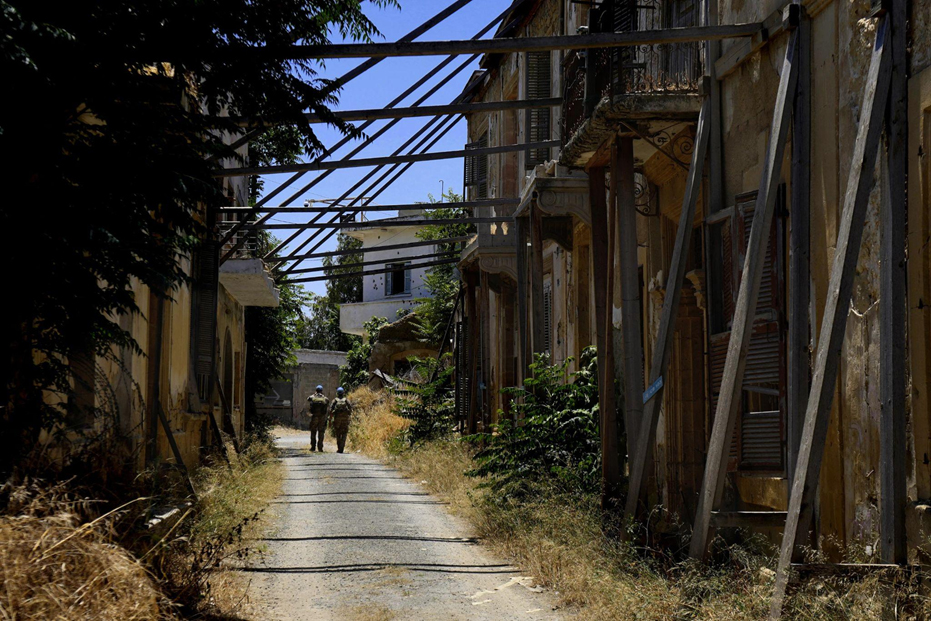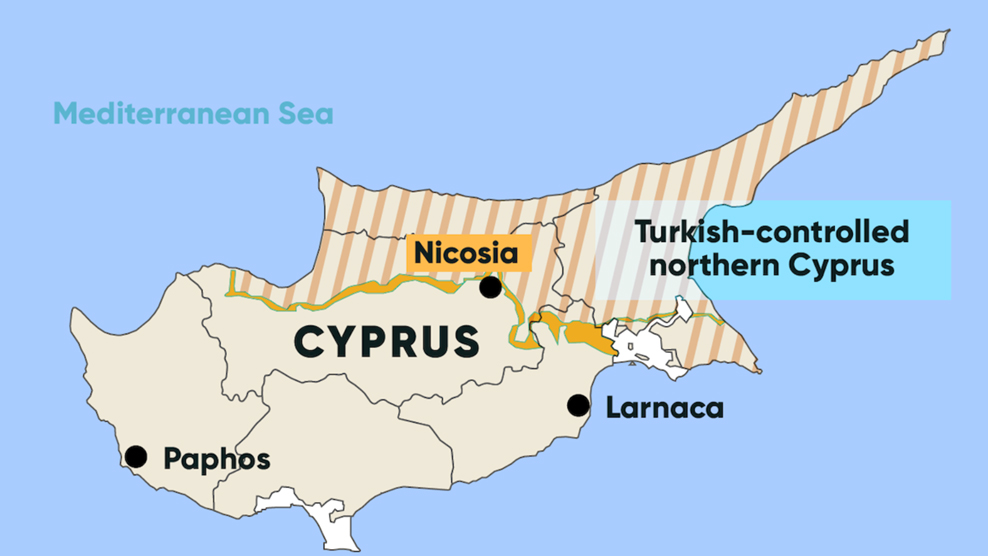The 1974 Turkish invasion of Cyprus represents one of the most dramatic and long- continuing frozen conflicts in the eastern Mediterranean. It was the capstone of decades of political conflict, ethnic division, and geopolitical competition, and it remade the islet’s fate in a manner that still shapes domestic politics to this day.
Cyprus before 1974
Cyprus itself is an island in the eastern Mediterranean whose strategic position made it a crossroads of empires, civilisations and societies. Subject to British imperial rule from 1878 to 1960, the islet had two major communities: the Greek Cypriots, who constituted roughly 80 percent of the population, and the Turkish Cypriots, the sizable minority of about 18 percent. Most Greek Cypriots held the dream of enosis, or the union with Greece, while the Turkish Cypriots dreaded marginalisation and vouched for taksim, or partition between Greece and Turkey.
A Fragile Power-Sharing
When Cyprus gained independence in 1960, the new nation was grounded on a fragile communal agreement. The President would always be a Greek Cypriot, the Vice President a Turkish Cypriot, and both groups were given proportional representation in government and the civil service. This arrangement was guaranteed by the Treaty of Guarantee, inked by Cyprus, Greece, Turkey, and the United Kingdom, which gave the guarantor powers the right to intervene if the domestic order was threatened.
Intercommunal Tensions and UN Peacekeeping (1963–1974)
The arrangement soon began to unravel. By 1963, just three years after independence, President Archbishop Makarios proposed amendments to the constitution that would reduce the Turkish Cypriot share in governance. The offer was rejected by the Turkish Cypriot leadership, and intercommunal fighting erupted throughout the islet. Turkish Cypriots retreated behind enclaves for protection, and the United Nations sent in the UN Peacekeeping Force in Cyprus (UNFICYP) in 1964 to command a buffer zone between the groups. Irrespective of this transnational presence, occasional violence and doubt continued, further pulling the communities far apart.
The broader indigenous setting further fuelled the tensions. In Greece, a right-wing military coup in 1967 championed enosis. Among Greek Cypriots, the radical group EOKA- B, led by-EOKA leader George Grivas, started a crusade of sabotage and killing against the Makarios government and against Turkish Cypriot forces. Turkey, for its part, constantly hovered over intervening militarily if Turkish Cypriots were attacked or if enosis was tried.
The 1974 coup
The extremity boiled over into its breaking point in July 1974. On 15 July, the Greek junta staged a coup in Cyprus, ousting Makarios and putting in Nikos Sampson, a notorious pro-enosis hardliner. For Turkey, the coup represented an outrageous breach of the Treaty of Guarantee and an immediate trouble to the Turkish Cypriot community. Ankara called for the reinstatement of the indigenous order. Diplomatic persuasion having failed, Turkey moved.
Operation Attila I: The First Turkish Offensive
At daylight on 20 July 1974, Turkey initiated what it termed a” peace operation” but which was appertained to internationally as the Turkish invasion of Cyprus. The operation, designated “Attila,” commenced with amphibious landings along the seacoast north of Kyrenia and airborne drops by paratroopers and battalions. Turkish forces fleetly secured a bridgehead and connected with Turkish Cypriot enclaves, while violent fighting broke out along the Green Line in Nicosia and other disputed zones. The Greek Cypriot National Guard, backed by units of the Greek service, fought hard but was weakened by disorganisation, poor collaboration, and the trauma of the coup only days earlier.
The United Nations Security Council, concerned at the speed of the developments, adopted Resolution 353 on 20 July demanding an immediate ceasefire, pullout of foreign military presence, and respect for the sovereignty of Cyprus. A ceasefire was reached on 22 July, but by this time Turkish forces held a thin corridor between Kyrenia and the northern edge of Nicosia. Meanwhile, there was a disastrous incident in what came to be called Operation Niki, a Greek attempt to resupply the islet with airborne battalions. Because of the lack of collaboration and the failure to communicate, some of the incoming aeroplanes were confused for Turkish aircraft and destroyed by friendly fire at great cost in lives.
Failed Negotiations and Attila II
Negotiations and talks amongst Greece, Turkey, and Britain commenced in Geneva late in July in the framework of the Treaty of Guarantee. The original round concluded with an uneasy ceasefire and a commitment to further conversations, but the root causes were still on the table. As the diplomats batted, on-the-ground developments progressed toward an alternate, larger offensive. On 14 August, citing the collapse of accommodating negotiations and continued attacks on Turkish Cypriots, Turkey pressed “Attila II”, a renewed offensive that snappily extended its hold to some 37 per cent of the island’s territory, including the strategic port city of Famagusta and the rich Mesaoria plain. The descent drove thousands of Greek Cypriots from the north and compelled Turkish Cypriots in the south to relocate north, effectively de facto partitioning the island.
The price in mortal terms was enormous. Some 200,000 Greek Cypriots, nearly a third of the islet’s population turned into refugees, abandoning their homes in the north for the south. Some 50,000 Turkish Cypriots, who had lived dispersed throughout the islet, were resettled in the Turkish-held north in a population transfer perfected by a 1975 agreement. Families were separated, houses left vacant, and whole municipalities were voided. There were massacres on each side, including most famously the murders of Turkish Cypriot dwellers in villages like Tochni and Maratha, and the massacre of Greek Cypriot captives of war and civilians amidst the mayhem of the fighting.
Political Aftermath: Partition and the Birth of Northern Cyprus
Politically, the invasion made Cyprus a partitioned islet. The Turkish- held north declared itself unilaterally the Turkish Republic of Northern Cyprus (TRNC) in 1983 and is only honoured by Turkey. The internationally honoured Republic of Cyprus, controlled by Greek Cypriots, held onto the southern two- thirds of the islet and kept the United Nations’ buffer zone, called the Green Line, which continues to divide Nicosia, the last disunited European capital.
Responses abroad to the invasion were varied. The UN denounced the military intervention and demanded the pullout of the foreign invading forces, but no enforcement action was taken. The United States, during the Watergate scandal and attached to NATO solidarity in the Cold War, put both sides under pressure but refused to defy Turkey, a major NATO supporter, directly. Greece for a brief period withdrew from NATO’s military command system in 1974, while Turkey was subordinated to arms embargoes by the US in the subsequent years. The Soviet Union condemned both the Turkish intervention and NATO’s failure to forestall it, utilising the extremity to identify splits in the Western alliance.

UN Buffer zone in Nicosia City. Source:APNEWS
The 1974 consequences still define the moment in Cyprus. Despite the state-sponsored negotiations, especially like the Annan Plan of 2004, which Turkish Cypriots voted in a favour, but Greek Cypriots rejected by an overwhelming majority, an agreement is still out of sight. The islet’s partition has grown increasingly deep-seated, with younger generations on both sides coming to know the other community veritably little if at all. Property conflicts, the fate of the missing population, and guarantees of security are some of the most longstanding issues in accommodations.
The invasion also reshaped the strategic balance in the eastern Mediterranean. The Turkish occupation of the northern third of Cyprus has left it with an endless presence in an area proximate to the Levant, Egypt, and important shipping lanes. For Greece, the loss was traumatic to the nation, recalled along with other Great Tragedies. For the European Union, which accepted the Republic of Cyprus as a member in 2004, division is an uncomfortable fact that half of its land is controlled by a non-member country.
From a humanitarian point of view, the tragedy of 1974 left lasting scars. Both refugee groups still recall the dislocation, and numerous Greek Cypriots retain documents to houses and property in the north that remain untouchable to them. The United Nations Committee on Missing Persons in Cyprus labours sluggishly to identify the bodies of those who disappeared during the conflict, furnishing comfort to cousins after numerous decades. Cultural heritage spots, churches, mosques, and cemeteries were neglected or defaced during and after the war, although some collaborative efforts for restoration have been made in recent times.
Lessons on Statehood
In the wider environment of history, the Turkish attack on Cyprus was not simply a localised disagreement; it was a Cold War extremity that uncovered the vulnerability of postcolonial statehood, the pitfalls of ethnic nationalism, and the weakness of International law when faced with strategic necessity. It is a stark reminder that political grievances left undetermined can suddenly explode into violence and that the impact can endure for generations.
A half-century on, Kyrenia’s shores and Famagusta’s quarter of Varosha stand silent testament to the summer of 1974. Holidaymakers can lie on the turquoise sand, and business can prosper in Nicosia’s bustling thoroughfares, but division of the island is always close at hand. The Green Line, which is guarded by UN peacemakers, is a physical and psychological hedge, dividing communities that were formerly neighbours. To numerous Cypriots, hope exists that ultimately the line will be forever carried as a piece of history, giving way to a united and tranquil islet. But the heritage of Turkish occupation, and the intricate blend of literal, political, and emotional fabric that it created, guarantees that the road to that future is as delicate a moment as it was in 1974.





